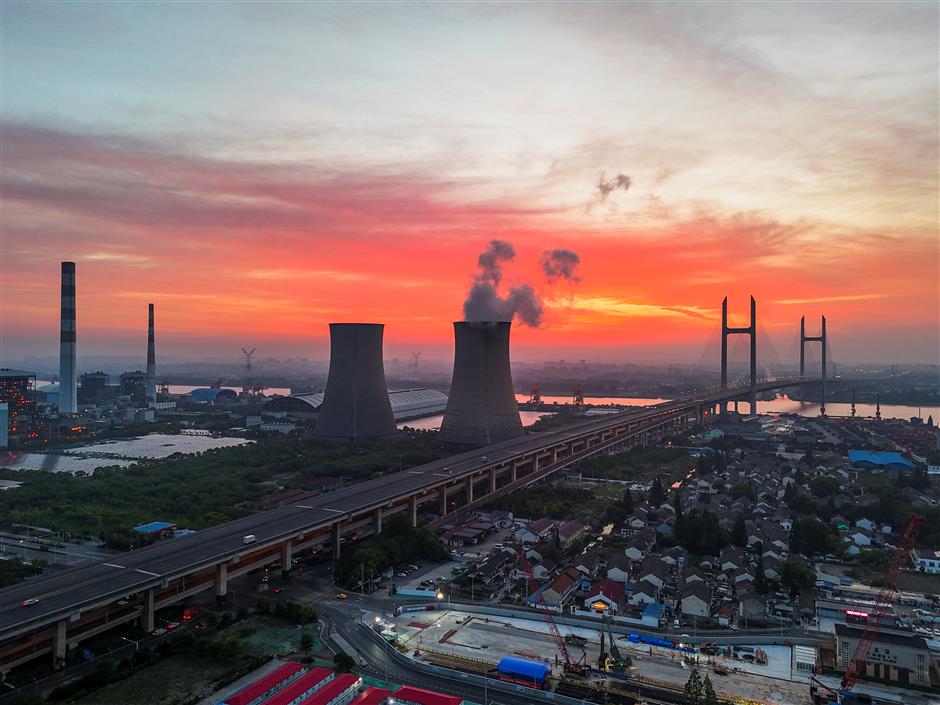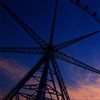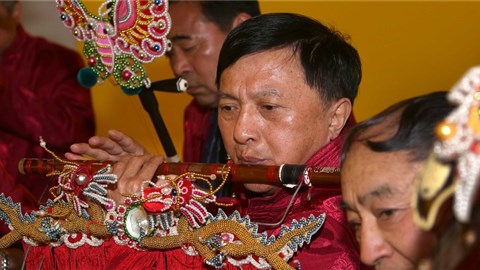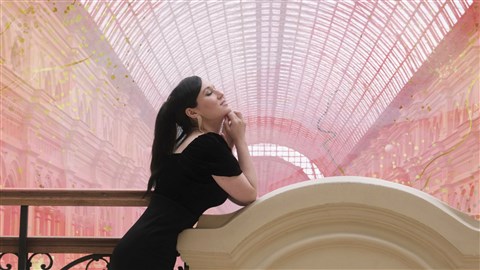Residents of former industrial town embrace its urbanization

A snapshot of Wujing Town by He Junwei. At the heart of the scene, the iconic twin cooling towers of Wujing Power Plant stand majestically.
The former industrial town of Wujing Town circled by the first bend of Huangpu River in south Minhang District has its landmark infrastructures of the Minpu Bridge and two giant cooling towers of Wujing Power Plant. On a dusk with flaming clouds, the bridge and the towers against a backdrop of the sunset glow form one of the best scenes of the town, proudly nicknamed by some photographers "Shanghai's 'Manhattan Bridge.'"
"They remind us of home," said He Junwei, a resident of Wujing, a young accountant and a drone pilot.
"When people traveled from out of town back to Shanghai through the S32 Shanghai-Jiaxing-Huzhou Highway, they saw the bridge and the towers and knew immediately they'd arrived home."
Wujing used to be an industrial town. Its Shanghai Carbon Plant, Shanghai Coking Plant, Wujing Chemistry Plant, Shanghai Electrification Plant and Wujing Thermal Power Plant were nicknamed the "Five Golden Flowers" of the town.
"That was an age eulogizing the strength of industrial workers," said He. "The generation of our parents were positive youths with cultivation. They were recruited into the factories and assigned to dorms in such places as Wujing No. 1 or No. 2 residential areas. Recruitment standards were also strict.
"When the workers retired, heavy industries in Shanghai had also fulfilled their missions."
Starting a year ago, He started to capture vistas of her hometown using an aerial drone.
"I record shots of Wujing for the purpose of introducing more people to the role it played and is continuing to play in the industrial development of Shanghai."
The two giant cooling towers appeared when He was in her adolescent years in the 1990s.
"They were not chimneys actually," He said. "Chimneys in a chemical plant are slender. The cooling towers were used in chilling steam and the water vapor emitted caused no pollution."
When the city's industrialization drew to an end, the majority of the past fundamental industry segments were either closed, relocated, or renovated for other purposes.
The Shanghai Carbon Plant is now a film industry base and above rural plots there rises the Zizhu High-tech Park, housing global corporates such as Microsoft, the Coca Cola company and SanDisk Semiconductor.
"My family house was among the first batch of rural houses dislocated for urban use when the project was carried out in 2002, followed by a wider scale of rural house dislocation, before the Shanghai World Expo's launch and the opening of traffic of Minpu Bridge in 2010," said He.
Construction of the Hongmei Elevated Road in 2016 and its opening to traffic greatly reduced the commute and cost between Wujing and downtown Shanghai, to half an hour.
The first image from an aerial perspective He captured was of Lanxiang Lake, a man-made lake of about 400,000 square meters, in Wujing.
"I was overwhelmed when my vision rose and I found out the Lanxiang Lake was in the shape of a key. The key is said to symbolize our access into a new trendy urban lifestyle, which I found later online," He said.
The lake is another landmark often now used for international sports competitions such as yachting and sailboarding.
"My grandparents' home used to be near the area of the current Lanxiang Lake, which was also near the first bend of the Huangpu River in its Minhang section. We as kids loved to see ships passing. It was a great amusement for us in our childhood, at a time when transportation was not well-connected and we heavily relied on ferries," He said.
He's drone camera passed over the La Chapelle young ladies' clothing park which is noted for its cherry blossoms in spring, the Yongde Road commercial street, and her former high school, which is now an affiliated school of East China Normal University.
She is planning on a documentary from an aerial perspective to record sites in Wujing such as the tallest Hangfa Building, the Wujing Ferry Station and Pujiang First Bay Park, among others.

Tahera Akter shows off Bangladeshi jute handicrafts.
PhD student follows steps of grandfather to Wujing
Bangladehi PhD student Tahera Akter had set her feet in China mainly because of her grandfather.
Akter, who studies journalism and communication at the Shanghai Jiao Tong University Minhang campus in Wujing Town, and her husband are the founders of Dada Bangla Ltd, a company trading in Bangladeshi jute handicrafts internationally.
The couple and their child are also new residents of a neighborhood in Wujing as of this year.
"'Dada' means 'grandfather' in Bangladeshi," Akter said. "I came to China inspired by my dada's emotional attachment to China."
Akter's dada was a farmer who had such a knack for farming that "China 32," a typical rice variety imported from China to Bangladesh, was first brought in by him.
China and Bangladesh have different weather and geographical conditions, yet Akter's dada took a risk and cultivated lots of rice.
"China 32" was widely and successfully planted by him and he was honored as best farmer of the year by the ministry of agriculture of Bangladesh.
When Akter graduated from Dhaka University from the capital Dhaka city, she had a chance to go abroad. She chose China for she had been captivated by the souvenirs and magazines on China her dada had collected and offered as her childhood readings. The elderly man never had a chance to visit the foreign land he was so fond of.
At the end of her MBA study in central Wuhan City, Akter decided she would like to be an entrepreneur to have big challenges and big risks, instead of a more traditional life.
In 2017 she headed for Shanghai. This year her Dada Bangla became a seventh-time full-attendance enrollee at the China International Import Expo.
"Not only China, the whole world was connected through the CIIE exhibition," said Akter, whose delicate jute handcrafts found buyers from China, Canada, Turkey and Japan. "And the university has its international teaching system that benefits us."
The fruitful business of Akter's is supported and nurtured by her home life in Wujing.
"When we first came to Shanghai, we lived in Wujing," she said.
"It has a big supermarket and some very traditional restaurants. I taste Chinese food and am inspired to cook Chinese food as well, such as tomato and egg soup, Kung Pao chicken, and stewed beef and radish."
Their child was born in Shanghai.
"In Bangladesh, if somebody was born in some place, he or she will be very emotionally attached to this place," Akter said.
When she was pregnant and went out for a walk in the residential area in Wujing, the elderly people there would talk with her, saying "How are you" and touching her belly.
"I felt too emotional," she said. "One of my neighbors would cook egg drop soup for me and told me if I ate it, my baby would be very clever."
When she was delivering her child, she saw Chinese doctors.
"There were no Bangladeshi people. Maybe my life was over, I just felt like this in a very critical situation. But when I woke and opened my eyes, I looked up at the Chinese doctors and nurses," she said.
"So when I go out for a walk in the Wujing Park, or along the Huangpu River, it's like this is my river and this is my place."
The couple's entrepreneurship, yielding fruitful economic results, also benefits about 2,000 vulnerable women in Bangladesh through jobs making jute handicrafts.
"Jute is an important plant in our country. The natural rain nurtures them. And in Bangladesh we also have one ministry called the Jute Ministry," Akter said. "It looks like vegetables, with long and green fiber. And after processing, it is so shiny."
Their jute handicrafts are of unique Bangladesh style, including animal-shaped or figurine-shaped ornaments, moisture-proof mattresses and weaved baskets. They have attracted throngs of visitors to pause and admire their booth during the 7th CIIE.
About Wujing Town 吴泾镇
Wujing boasts a 13.7-kilometer-long Huangpu River shoreline and 2.5 square kilometers of lake and river resources. While carrying out its development purpose for a "lifelong dwelling place," the town adopts a "Park+" urban construction vision in the hope that its residents can reach its greenery resources within a walk of 10 minutes.
















